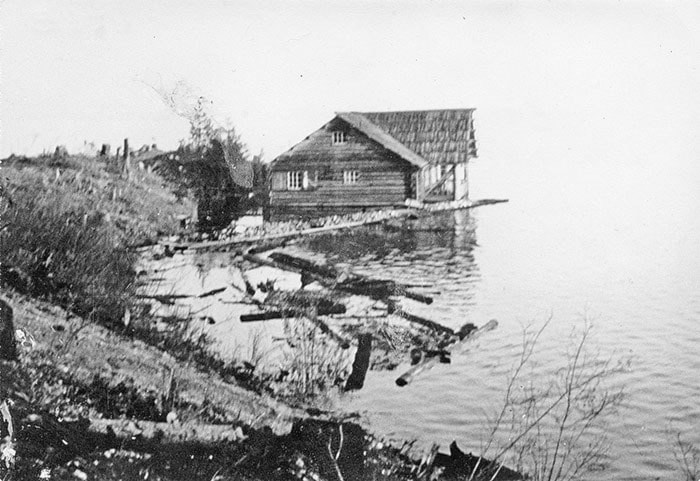Suzanne Bonner
Museum at Campbell River
In 1930, a lodge was built on the western shore of Upper Campbell Lake for a Mr. and Mrs. Henning Berg of San Francisco.
The couple contracted Norwegian architect Jack Earsland to design the lodge that was to be their summer wilderness retreat.
In early spring, cedar trees were felled while the sap was running, then peeled and oiled, leaving the logs with a golden hue. The logs were then grooved and notched for an interlocking fit, and secured with two-foot drift bolts. The carpenters, Jasper, Walter, and Bill Sutherland, Jack Phillips, Axel Magnessen, Herbert Pidcock and Jim Calnan, camped out next to the lodge in tents as they worked.
For several years the Henning Bergs enjoyed their secluded lodge, fishing, hunting, and hiking the rugged wilderness around them.
When Henning Berg passed suddenly in the early 30s, his widow sold the lodge to Mr. and Mrs. Whittaker of Victoria.
The Whittakers opened the lodge’s doors to the public, running it as an exclusive resort –Strathcona Lodge – for nearly two decades.
In 1955 the B.C. Power Commission announced that it would begin construction of a dam between Upper and Lower Campbell Lakes that would cause the water level of Upper Campbell to rise approximately 110 feet. In preparation for the flooding, the Power Commission bought out all privately owned properties along the Lake’s shoreline, including Strathcona Lodge.
The following year, in an October issue of the Courier newspaper, the Power Commission listed an advertisement for the sale of the Strathcona Lodge. The ad read: Building for Sale … Bids for the purchase of the structure and fixtures of the buildings at Upper Campbell Lake formerly known as Strathcona Lodge are invited on an as is, where is basis. The successful bidder must be prepared to remove the building and contents by Nov. 7, after which the Power Commission will destroy the residue.
Wallace Baikie and his two brothers Harper and Jack of Baikie Brothers Logging stepped forward, offering $500 for the main lodge.
The offer was accepted and the brothers set to work. They tore out the bottom floor and drove cedar logs beneath the structure for a makeshift raft. As the water level began to rise, the lodge rose with it. For a year it rested in quiet solitude, afloat on the lake, until in 1958 the water level reached its mark.
The Baikie family got together, and with the aid of friends, bulldozers, and winches, the lodge was hauled from its sodden raft and onto the slope of Upper Campbell’s eastern shore – directly across the lake from its original location.
Wallace Baikie’s daughter Myrna, and her husband Jim Boulding, were both local teachers who wanted to start a summer camp for boys. Together, the Bouldings with support from Wallace Baikie, restored the lodge to its former elegance.
New additions included a reception hall, a larger kitchen and two new wings. Bunkhouses from the Baikie Bros. logging camp at Dolly Varden Point, also saved from being flooded, were floated over and refurbished to make guesthouses, and a wharf deck that had been used for the company’s log dump found new purpose as a boat dock.
From that point on, Jim and Myrna Boulding dedicated themselves to developing Strathcona Park Lodge into a leading outdoor education centre and wilderness retreat.
